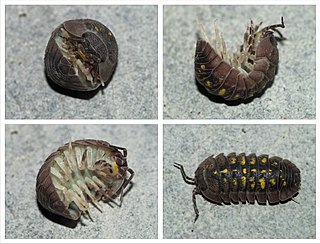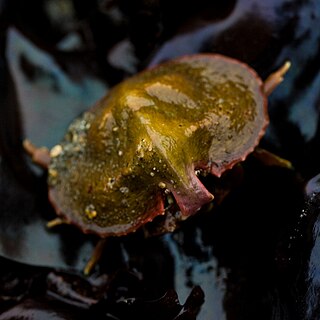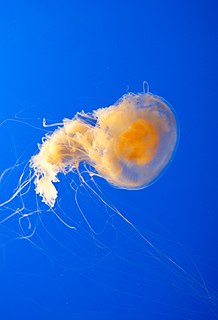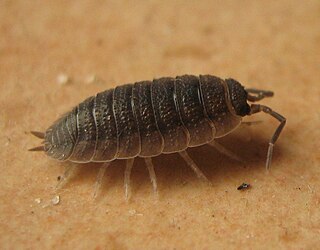 W
WThe family Aplodontiidae also known as Aplodontidae, Haplodontiidae or Haploodontini is traditionally classified as the sole extant family of the suborder Protrogomorpha. It may be the sister family of the Sciuridae. There are fossils from the Oligocene until Miocene in Asia, from Oligocene in Europe and from the Oligocene until the present in North America, where there is the only living species: the mountain beaver.
 W
WArmadillidium is a genus of the small terrestrial crustacean known as the woodlouse. Armadillidium are also commonly known as pill woodlice, leg pebbles, pill bugs, roly-poly, or potato bugs, and are often confused with pill millipedes such as Glomeris marginata. They are characterised by their ability to roll into a ball ("volvation") when disturbed.
 W
WThe Armenian cochineal, also known as the Ararat cochineal or Ararat scale, is a scale insect indigenous to the Ararat plain and Aras (Araks) River valley in the Armenian Highlands. It was formerly used to produce an eponymous crimson carmine dyestuff known in Armenia as vordan karmir and historically in Persia as kirmiz. The species is critically endangered within Armenia.
 W
WBrandt's cormorant is a strictly marine bird of the cormorant family of seabirds that inhabits the Pacific coast of North America. It ranges, in the summer, from Alaska to the Gulf of California, but the population north of Vancouver Island migrates south during the winter. Its specific name, penicillatus is Latin for a painter's brush, in reference to white plumes on its neck and back during the early breeding season. The common name honors the German naturalist Johann Friedrich von Brandt of the Academy of Sciences at St. Petersburg, who described the species from specimens collected on expeditions to the Pacific during the early 19th century.
 W
WCryptolithodes typicus, often referred to as the butterfly crab or the turtle crab, is a species of lithodid crustacean native to coastal regions of the northeastern Pacific Ocean, ranging from Amchitka Island, Alaska to Santa Rosa Island, California.
 W
WChrysaora melanaster, commonly known as the northern sea nettle or brown jellyfish, is a species of jellyfish native to the northern Pacific Ocean and adjacent parts of the Arctic Ocean. It is sometimes referred to as a Pacific sea nettle, but this name is also used for C. fuscescens; the name Japanese sea nettle was also used for this species, but that name now exclusively refers to C. pacifica. Although jellyfish kept in public aquariums sometimes are referred to as C. melanaster, this is the result of the historical naming confusion and these actually are C. pacifica.
 W
WColobognatha is a clade of helminthomorph millipedes containing four orders: Platydesmida, Polyzoniida, Siphonocryptida, and Siphonophorida.
 W
WCryptolithodes sitchensis, variously known as the umbrella crab, Sitka crab or turtle crab, is a species of lithodid crustacean native to coastal regions of the northeastern Pacific Ocean, ranging from Sitka, Alaska to Point Loma, California. Its carapace extends over its legs such that when it pulls in its legs, it resembles a small stone. It lives in rocky areas from the low intertidal to depths of 17 m (56 ft).
 W
WFlying squirrels are a tribe of 50 species of squirrels in the family Sciuridae. They are not capable of flight in the same way as birds or bats but are able to glide from one tree to another with the aid of a patagium, a furry, parachute-like membrane that stretches from wrist to ankle. Their long tail provides stability in flight. Anatomically they are very similar to other squirrels but have a number of adaptations to suit their lifestyle; their limb bones are longer and their hand, foot bones and distal vertebrae are shorter. Flying squirrels are able to steer and exert control over their glide path with their limbs and tail.
 W
WHolochilus is a genus of semiaquatic rodents in the tribe Oryzomyini of family Cricetidae, sometimes called marsh rats. It contains three living species, H. brasiliensis, H. chacarius, and H. sciureus, which are widely distributed in South America east of the Andes. A fourth species from the Pleistocene of Bolivia was formerly classified as H. primigenus, but is now placed in the genus Reigomys.
 W
WThe Lagomorphs are the members of the taxonomic order Lagomorpha, of which there are two living families: the Leporidae and the Ochotonidae (pikas). The name of the order is derived from the Ancient Greek lagos + morphē. There are 102 extant species of lagomorph, including 37 species of pika, 33 species of rabbit and cottontail, and 32 species of hare.
 W
WThe Macquarie shag, Macquarie Island shag or Macquarie Island cormorant, is a marine cormorant native to Macquarie Island in the Southern Ocean, about halfway between Australia and Antarctica.
 W
WThe suborder Myomorpha contains 1,137 species of mouse-like rodents, nearly a quarter of all mammal species. Included are mice, rats, gerbils, hamsters, lemmings, and voles. They are grouped according to the structure of their jaws and molar teeth. They are characterized by their myomorphous zygomasseteric system, which means that both their medial and lateral masseter muscles are displaced forward, making them adept at gnawing. As in the hystricognathous rodents, the medial masseter muscle goes through the eye socket, a feature unique among mammals. Myomorphs are found worldwide in almost all land habitats. They are usually nocturnal seed-eaters.
 W
WPallas's cat, also called the manul, is a small wild cat with a broad, but fragmented distribution in the grasslands and montane steppes of Central Asia. It is negatively affected by habitat degradation, prey base decline and hunting. It has been classified as Least Concern on the IUCN Red List since 2020.
 W
WOtospermophilus is a genus of ground squirrels in the family Sciuridae, containing three species from Mexico and the United States. Otospermophilus was formerly placed in the large ground squirrel genus Spermophilus, as a subgenus or species group. Since DNA sequencing of the cytochrome b gene has shown Spermophilus to be paraphyletic to the prairie dogs and marmots, it is now separated, along with six other genera.
 W
WParalithodes is a genus of North Pacific king crabs.
 W
WParalithodes platypus, the blue king crab, is a species of North Pacific king crab which lives near St. Matthew Island, the Pribilof Islands, and the Diomede Islands, Alaska, with further populations along the coasts of Japan and Russia. Although blue king crabs are among the largest crabs in the world and reputedly may exceed 18 pounds (8.2 kg) in weight, they are generally smaller than red king crabs.
 W
WPhacellophora camtschatica, commonly known as the fried egg jellyfish or egg-yolk jellyfish, is a very large jellyfish in the family Phacellophoridae. This species can be easily identified by the yellow coloration in the center of its body which closely resembles an egg yolk, hence how it got its common name. Some individuals can have a bell close to 60 cm (2 ft) in diameter, and most individuals have 16 clusters of up to a few dozen tentacles, each up to 6 m (20 ft) long. A smaller jellyfish, Cotylorhiza tuberculata, typically found in warmer water, particularly in the Mediterranean Sea, is also popularly called a fried egg jellyfish. Also, P. camtschatica is sometimes confused with the Lion's mane jellyfish.
 W
WPisaster ochraceus, generally known as the purple sea star, ochre sea star, or ochre starfish, is a common starfish found among the waters of the Pacific Ocean. Identified as a keystone species, P. ochraceus is considered an important indicator for the health of the intertidal zone.
 W
WPorcellionidae is a terrestrial family of the order Isopoda.
 W
WFlying squirrels are a tribe of 50 species of squirrels in the family Sciuridae. They are not capable of flight in the same way as birds or bats but are able to glide from one tree to another with the aid of a patagium, a furry, parachute-like membrane that stretches from wrist to ankle. Their long tail provides stability in flight. Anatomically they are very similar to other squirrels but have a number of adaptations to suit their lifestyle; their limb bones are longer and their hand, foot bones and distal vertebrae are shorter. Flying squirrels are able to steer and exert control over their glide path with their limbs and tail.
 W
WCassin's auklet is a small, chunky seabird that ranges widely in the North Pacific. It nests in small burrows and because of its presence on well studied islands in British Columbia and off California it is one of the better known auks. It is named for the American ornithologist John Cassin.
 W
WThe Russian sturgeon, also known as the diamond sturgeon or Danube sturgeon, is a species of fish in the family Acipenseridae. It is found in Azerbaijan, Bulgaria, Georgia, Iran, Kazakhstan, Romania, Russia, Turkey, Turkmenistan, and Ukraine. It is also found in the Caspian Sea. This fish can grow up to about 235 cm (93 in) and weigh 115 kg (254 lb). Russian sturgeon mature and reproduce slowly, making them highly vulnerable to fishing. It is distinguished from other Acipenser species by its short snout with a rounded tip as well as its lower lip which is interrupted at its center.
 W
WSciuromorpha ("squirrel-like") is a rodent clade that includes several different rodent families. It includes all members of the Sciuridae as well as the mountain beaver species.
 W
WSolenodons are venomous, nocturnal, burrowing, insectivorous mammals belonging to the family Solenodontidae. The two living solenodon species are the Cuban solenodon, and the Hispaniolan solenodon. Both species are classified as "Endangered" due to habitat destruction and predation by non-native cats, dogs and mongooses, introduced by humans to the solenodons' home islands to control snakes and rodents.
 W
WThe spectacled eider is a large sea duck that breeds on the coasts of Alaska and northeastern Siberia.
 W
WThysanoessa is a genus of krill, containing the following species:Thysanoessa gregaria G. O. Sars, 1885 Thysanoessa inermis (Krøyer, 1846) Thysanoessa inspinata Nemoto, 1963 Thysanoessa longicaudata (Krøyer, 1846) Thysanoessa longipes Brandt, 1851 Thysanoessa macrura G. O. Sars, 1885 Thysanoessa parva Hansen, 1905 Thysanoessa raschii (M. Sars, 1864) Thysanoessa spinifera Holmes, 1900 Thysanoessa vicina Hansen, 1911